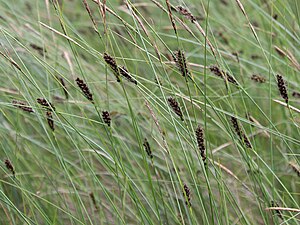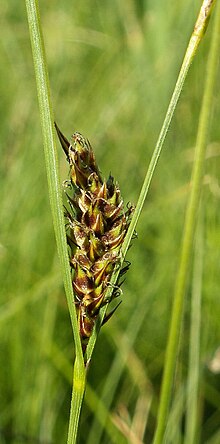Thread sedge
| Thread sedge | ||||||||||||
|---|---|---|---|---|---|---|---|---|---|---|---|---|

Thread sedge ( Carex lasiocarpa ) |
||||||||||||
| Systematics | ||||||||||||
|
||||||||||||
| Scientific name | ||||||||||||
| Carex lasiocarpa | ||||||||||||
| Honor |
The thread sedge ( Carex lasiocarpa ) is a species of the genus Seggen ( Carex ) within the sour grass family (Cyperaceae). It is widespread in the northern hemisphere in temperate to boreal and subarctic areas of Eurasia and North America .
description
Vegetative characteristics
The thread sedge is a perennial herbaceous plant and reaches heights of 30 to 100 (rarely 120) centimeters. It forms a long creeping rhizome and therefore grows in loose grass . The upright stem is thin, rather rounded, smooth, at most slightly rough on top and without leaves on top. The gray-green, hairless leaves are stiff, up to 100 centimeters long and with a width of 1 to 1.5 millimeters, relatively narrow and curled up. The basal leaf sheaths are light to dark brown, often tinged with reddish; they fray.
Generative characteristics
The flowering time is in May and June. The thread sedge is a variegated sedge. There are usually two (one to three) distant female spikelets . The female spikelets are up to 3 inches long and many-flowered. She. The lowest spikelet is stalked up to 2 inches long. There are one to three male spikelets that are up to two inches long. The lowest bract is herbaceous, towers over the inflorescence and has a short sheath. The bracts are dark brown and have a light skin edge. They are pointed or short awned, have a light central vein and are the same length as or shorter than the fruit. The stylus has three scars .
The 3.5 to 5 millimeters long, gray-green fruit is elongated-egg-shaped, slightly puffed up, hairy, longitudinally veined and short beaked.
The number of chromosomes is 2n = 56.
Occurrence
The filamentous sedge is circumpolar and is a moderate to boreal flora element . It occurs in the northern hemisphere in temperate to boreal areas of Eurasia and North America . There are sites in France , Spain , Germany , Austria , Switzerland , Italy , Denmark , Norway , Sweden , Finland , Ireland , the United Kingdom , Belgium , the Czech Republic , Hungary , the Netherlands , Poland , Slovakia , Belarus , Estonia , Lithuania , Latvia , Moldova , European part of Russia , Ukraine , Bulgaria , Croatia , Montenegro , Romania , Serbia , Slovenia , Armenia , Georgia , Ciscaucasia, Siberia , Russia's Far East , Kazakhstan , northern Mongolia , in the Chinese provinces of Heilongjiang and Nei Monggol , on the Japanese islands of Hokkaidō and Honshu , in Korea , in the Canadian provinces of Yukon Territory , Newfoundland, Nova Scotia , Ontario , Prince Edward Island, Quebec, St. Pierre and Miquelon, British Columbia , Manitoba , Saskatchewan and the US states of Connecticut , Indiana , Maine , Massachusetts , Michigan , New Hampshire , New Jersey , New York, Ohio , P Pennsylvania , Rhode Island , Vermont , Illinois , Iowa , Minnesota , Wisconsin, Idaho , Montana , Washington, Virginia, as well as California and the Mexican state of Baja California .
It is widespread in Germany in the Alps and their foreland , otherwise scattered. In Germany it grows in low-lime flat and intermediate moors, on the edge of upland moor lakes, in ditches and ditches. It also goes to the edge of raised bogs and in litter meadows with little base. The filamentous sedge grows in Central Europe on peaty subsoil, but it also grows on loose, base - and nitrogen-poor mud ; she is shy of lime .
It occurs in Germany from the colline to the montane altitude level at altitudes of up to 1500 meters. In the Allgäu Alps , it rises in Vorarlberg southwest of the Breiten-Alpe am Schrannenbach north of Schoppernau to an altitude of 1540 meters. It thrives in Switzerland on the hill and in the montane, sometimes sub- alpine belt in Central Plateau , in Jura, in the Northern Alps (only external chains) in Grisons us in the southern Ticino ago. It occurs in northern Italy .
Taxonomy and systematics
Carex lasiocarpa was first published in 1784 by Jakob Friedrich Ehrhart .
From Carex lasiocarpa Ehrh. there are three varieties:
- Carex lasiocarpa var. Americana Fernald ( Syn . : Carex lasiocarpa subsp. Americana (Fernald) Á.Löve & J.-P.Bernard , Carex filiformis var. Lanuginosa (Michx.) Britton , Carex lanuginosa Michx. , Carex lanuginosa var. Americana (Fernald) B.Boivin , Carex lanuginosa var. kansana Britton , Carex lasiocarpa var. lanuginosa . (. Michx) KUek , Carex lasiocarpa subsp. lanuginosa (Michx.) RTClausen & Wahl , Carex lanuginosa var. oriens Raymond ): it is the subarctic North America from Alaska and Canada (British Columbia, Labrador, Manitoba, Newfoundland, Northwest Territories, Nova Scotia, Ontario, Prince Edward Islands, Québec, Saskatchewan) over large areas of the northern, western and central United States (states Washington, California, Connecticut , Georgia, Idaho, Illinois, Indiana, Iowa, Massachusetts, Michigan, Minnesota, Montana, New Hampshire, New Jersey, New York, Ohio, Pennsylvania, Rhode Island, Vermont, Virginia, Wisconsin) to the Mexican state of Ba yes California widespread.
- Carex lasiocarpa Ehrh. var. lasiocarpa (Syn .: Carex splendida Willd. , Carex filiformis var. latifolia Boeckeler , Carex filiformis var. australis L.H.Bailey ): It is widespread in the temperate areas of Eurasia .
- Carex lasiocarpa var. Occultans (Franch.) Kük. (Syn .: Carex filiformis var. Occultans Franch. , Carex occultans (Franch.) VIKrecz. , Carex lasiocarpa var. Fuscata Ohwi , Carex lasiocarpa subsp. Occultans (Franch.) Hultén , Carex koidzumii Honda , Carex koidzumii var. Fuscata (Ohwi ) Ohwi ): It occurs from Korea via Sakhalin to Japan .
Taxonomic meaning
The name of the plant group Carion lasiocarpa is derived from Carex lasiocarpa by adding the suffix -ion . Carex lasiocarpa is a character species of the Caricetum lasiocarpae.
literature
- Rudolf Schubert , Klaus Werner, Hermann Meusel (eds.): Excursion flora for the areas of the GDR and the FRG . Founded by Werner Rothmaler. 13th edition. tape 2 : vascular plants . People and knowledge, Berlin 1987, ISBN 3-06-012539-2 (area).
- Siegmund Seybold (Ed.): Schmeil-Fitschen interactive . CD-ROM, version 1.1. Quelle & Meyer, Wiebelsheim 2002, ISBN 3-494-01327-6 .
- Dietmar Aichele, Heinz-Werner Schwegler: The flowering plants of Central Europe . 2nd Edition. tape 5 : Swan flowers to duckweed plants . Franckh-Kosmos, Stuttgart 2000, ISBN 3-440-08048-X .
Individual evidence
- ↑ a b c d e f g Rafaël Govaerts (Ed.): Carex lasiocarpa. In: World Checklist of Selected Plant Families (WCSP) - The Board of Trustees of the Royal Botanic Gardens, Kew . Retrieved October 22, 2016.
- ↑ a b Erich Oberdorfer : Plant-sociological excursion flora for Germany and neighboring areas . With the collaboration of Angelika Schwabe and Theo Müller. 8th, heavily revised and expanded edition. Eugen Ulmer, Stuttgart (Hohenheim) 2001, ISBN 3-8001-3131-5 , pp. 193 .
- ↑ Lun-Kai Dai, Prof. Song-Yun Liang, Shuren Zhang, Yancheng Tang, Tetsuo Koyama, Gordon C. Tucker: Carex. In: Wu Zheng-yi, Peter H. Raven, Deyuan Hong (Eds.): Flora of China . Volume 23: Acoraceae through Cyperaceae . Science Press / Missouri Botanical Garden Press, Beijing / St. Louis 2010, ISBN 978-1-930723-99-3 , Carex lasiocarpa. , S. 413 (English, online ).
- ↑ a b c Carex lasiocarpa in the IUCN Red List of Threatened Species 2016.2. Posted by: RV Lansdown, 2014. Retrieved October 22, 2016.
- ^ Peter W. Ball, AA Reznicek: Carex. In: Flora of North America Editorial Committee (Ed.): Flora of North America North of Mexico . Volume 23: Magnoliophyta: Commelinidae (in part): Cyperaceae . Oxford University Press, New York / Oxford a. a. 2002, ISBN 0-19-515207-7 , Carex lasiocarpa. , S. 497 (English, online ).
- ^ Carex lasiocarpa in the Germplasm Resources Information Network (GRIN), USDA , ARS , National Genetic Resources Program. National Germplasm Resources Laboratory, Beltsville, Maryland. Retrieved August 22, 2015.
- ↑ Erhard Dörr, Wolfgang Lippert : Flora of the Allgäu and its surroundings. Volume 1, IHW, Eching 2001, ISBN 3-930167-50-6 , p. 283.
- ↑ Carex lasiocarpa Ehrh. In: Info Flora , the national data and information center for Swiss flora .
- ↑ Data sheet from Schede di Botanica - Flora Italiana .
- ↑ Jakob Friedrich Ehrhart: Botanical Remarks (continued). In: Hanoverian magazine. Volume 22, No. 9, pp. 129-144 ( here: p. 132 ).
- ^ Carex lasiocarpa at Tropicos.org. Missouri Botanical Garden, St. Louis, accessed August 22, 2015.
- ↑ Josias Braun-Blanquet. Plant sociology, Chapter XV: Classification of Communities. page 364
Web links
- Carex lasiocarpa Ehrh., Thread sedge. In: FloraWeb.de.
- Thread sedge . In: BiolFlor, the database of biological-ecological characteristics of the flora of Germany.
- Profile and distribution map for Bavaria . In: Botanical Information Hub of Bavaria .
- Carex lasiocarpa Ehrh. In: Info Flora , the national data and information center for Swiss flora .
- Carex lasiocarpa at Tropicos.org. In: IPCN Chromosome Reports . Missouri Botanical Garden, St. Louis
- Distribution in the northern hemisphere from: Eric Hultén, Magnus Fries: Atlas of North European vascular plants. 1986, ISBN 3-87429-263-0 at Den virtuella floran. (swed.)
- Thomas Meyer: Data sheet with identification key and photos at Flora-de: Flora von Deutschland (old name of the website: Flowers in Swabia ).
- Wanted poster with photos.


